- Effects of alloy ratio and coating thickness on temperature distribution of thermal barrier coatings
Can Ozturka and Tolga Demircanb,*
aDepartment of Mechanical Engineering, Faculty of Engineering, Kırıkkale University, Kırıkkale, Turkey
bDepartment of Mechanical Engineering, Faculty of Engineering, Kırıkkale University, Kırıkkale, Turkey
Pistons on internal combustion
engines that are constantly subjected to high pressure and temperature should
be light, resistant to heat, resistant to corrosion and have adequate hardness
to work more efficiently and to have longer lifecycles. For this purpose,
piston surfaces are coated with thermal barrier that increases resistance
against heat and corrosion. In this study, temperature distribution on piston
surfaces were numerically analysed for ceramic coating on a piston. For this
purpose, it is assumed that 100 μm NiCrAl coating is applied as bond coat
on piston upper surface. This coating was coated with MgZrO3+NiCrAl
alloy with different alloy ratios for different coating thicknesses. MgZrO3+NiCrAl
alloy thickness was changed between 200 µm and 600 µm. For all
analysed coating thicknesses, MgZrO3 ratio in the alloy was changed
between 100 to 10% and simulations were repeated for different alloy rates. As
a result of these analysis, it was determined that as MgZrO3 ratio
in the alloy decreased, piston upper surface temperature decreased as well. For
all alloy ratios, maximum temperature was observed on piston upper surface.
Additionally, it was determined that as piston upper surface coating thickness
increased, piston upper surface temperature increased as well.
Keywords: Functional ceramic coating, Thermal barrier coating, Coating thickness, Coating alloy ratio
As ceramic materials have high resistance, and can conduct
heat and electricity at high levels, this material is commonly used in
engineering applications to increase efficiency and durability.
One of these materials is known as zirconium dioxide. ZrO2
is used in aviation industry, gas turbines, and certain engine components. In
this study, the purpose was to apply Magnesium ZrO3, which is a
zirconium-based ceramic on piston surface in graded way. The purpose of using
different functional graded materials on a piston is to increase piston
resistance, enable upper surface of piston to achieve higher temperatures,
thus, increase overall efficiency. For this purpose, in this study, different
coating ratios and thickness with MgZrO3 (Magnesium zirconium oxide)
and connection layer that will be applied on the upper surface of a designed
diesel engine piston was calculated numerically. After the analysis, maximum
and minimum temperature changes were obtained for diesel engine piston. Some of
the studies in the literature regarding piston ceramic coating were given
below.
Cerit and Çoban [1] numerically analysed thermal
properties of an aluminium alloy piston coated with ceramic in a diesel engine.
Authors compared tem- perature values
for coated and uncoated piston by using finite element analysis. Authors stated
that temperature values of coated piston surface was higher than
uncoated piston surface. Büyükkaya [2]
analysed thermal behaviours of functional graded
aluminium-silicon alloy piston and steel pistons with package program. Author
compared temperature values of piston coated with AlSi allow and uncoated
piston. As a result, author found that piston surface value of FGM coated AlSi
piston was 28% higher than uncoated piston surface temperature. It was observed
that surface temperature of steel piston increased 17%. Büyükkaya and Cerit [3]
conducted numerical 3 dimensional thermal analysis on ceramic coated diesel
engine piston. MgO, ZrO, and AlSi alloy coated pistons and uncoated pistons
were simulated. It was observed that maximum surface temperature of steel
piston was higher than AlSi alloy piston.
Gehlot and Tripathi [4] evaluated thermal analysis of
holes that are created to coat ceramic to the piston of a diesel engine.
Analysis were conducted for piston geometries with 1.5 mm, 2 mm, and
2.5 mm radius holes. Authors observed that as radius of holes
increased, temperature of upper surface (coated
surface) increased, and when coats had holes, upper surface
temperature levels of piston significantly increased. Cerit et al. [5] analysed
effect of partially ceramic coated piston use in spark ignition engine on HC
emission. For engine tests, both standard piston and coated piston was selected.
Authors observed that with coating, surface temperature
of piston increased up to 100 oC. Robinson and Palaninathan [6]
conducted thermal analysis for piston cast by using three dimensional finite
element method. Authors determined that the thinnest part solidifies in one
second while middle part solidifies after sixty seconds.
Kummitha and Reddy [7] numerically analysed thermal
effect of using different materials on winged cylinder block. Authors
determined that heat transfer speed of the material was linked with
thermal conductivity of material.
Dudareva et al. [8] analysed microarc oxidation (MAO)
coating application for thermal protection of internal combustion engine piston
upper surface. Tests were conducted for 76 and 106 μm MAO coating thicknesses
and it was determined that piston temperatures decreased
by 45 and 78 oC respectively. Dhinest et al. [9] numerically
and experimentally analysed thermal properties of coated diesel engine that
works with nano biofuel. For this purpose, engine piston, valves and cylinder
head was coated with YSZ (Yttria-stabilised zirconia) coating. As a result, it
was determined that average temperatures of these components increased, harmful
emission decreased and engine thermal efficiency increased
by 1.75% compared to conventional engines. Yao et al. [10] analysed effects of
thermal barrier coating on a diesel engine on combustion and resulting
emissions. For this purpose, simulations are conducted for two different engine
loads (6 bar IMEP and 17.9 bar IMEP). Results of their study showed that
thermal barrier applications have the ability to decrease thermal transfer
losses on piston walls and this might increase engine thermal efficiency. Lu et
al. [11] analysed effects of diesel engine YSZ thermal barrier coating
application on thermal behaviour. Authors reported that coating application
significantly affected piston peak temperature distribution. It
was observed that as coating thickness increased, piston upper
surface temperature increased and coating and piston mid-surface
temperature decreased. Authors stated that this might lead lower
thermal loss in combustion chamber and increased thermal efficiency.
Muthusamy et al. [12] experimentally analysed effect of
engine piston thermal barrier coating (8YSZ-TiO2-Al2O3)
application on engine efficiency and resulting emissions. For same operating
conditions, it was observed that thermal efficiency increased 5.99% for thermal
barrier coating practice compared to uncoated condition. On the other hand,
specific fuel consumption decreased by 0.06 kg/kWh. It was also noted that
combustion caused HC and CO emission decreased as well. Cerit [13] analysed
effects of coating thickness and size of a ceramic coated internal combustion
engine piston on temperature and stress distribution. As coating
thickness increased, it was observed that coating surface
temperature increased as well. With increasing coating thickness, it was noted
that normal stress on piston surface decreased and shear stress slightly
increased. For analysed coating thickness, optimal coating thickness value was
identified as 1 mm. Sachit et al. [14] numerically analysed thermal
effects of Cr2O3 coating on diesel engine piston upper
surface. Their study showed that Cr2O3
coating on piston surface increased surface temperature
compared to uncoated condition.
Yao and Qian [15] investigated effects of nano-ceramic
coated piston use in natural gas engine on piston
temperature distribution. Authors compared these results with
uncoated piston. For those parameters, piston upper surface temperature of
coated piston had approximately 44% higher average temperature than uncoated piston
and piston coating bottom average temperature decreased approximately 12%.
Mahade et al. [16] analysed effects of YSZ coating thickness in gadolinium
zirconate/YSZ couple on resistance. To determine thermal conductivity and
thermal shock lifecycle of Thermal Barrier Coating, experiments were conducted
for different gadolinium zirconate (GZ) and YSZ thicknesses. Minimum thermal
conductivity was observed for thinnest YSZ coating. Additionally, it was reported
that as YSZ thickness increased, thermal shock lifecycle
decreased. Garud et al. [17] analysed effects of a diesel engine piston surface
thermal barrier coating (YSZ) application on engine
performance and combustion properties. For this purpose,
piston upper surface was coated with 250 micron thick YSZ (Y2O3
& ZrO2) ceramic material with plasma spraying technique. As a
result, it was observed that piston upper surface YSZ thermal barrier coating
increased engine break thermal efficiency by 1.4% compared to uncoated
condition.
Yao et al. [18] experimentally and numerically analysed
Nano PYSZ Thermal Barrier Coating on temperature and thermal
load distribution. For this purpose, aluminium allow piston
surfaces were coated with Nano PYSZ thermal barrier. As a result, it was
observed that Nano PYSZ coated piston lower layer temperatures
decreased by 16% compared to uncoated piston.
It was determined that piston upper surface temperature approximately
increased 52%. Authors reported that this could increase
engine combustion chamber temperature and engine efficiency. Venkadesan and
Muthusamy [19] experi- mentally
analysed Al2O3/8YSZ and CeO2/8YSZ alloy
coating of diesel engine piston surfaces on engine performance and emission
properties. For this purpose, aluminium piston upper surface was first coated with
CoNiCrAlY bonding layer. These layers were coated with two different coating
material as 20%Al2O3/80%8YSZ and 20%CeO2/80%8YSZ and experiments were
conducted. Results showed that CeO2/8YSZ based coating had better
thermal cycle behaviour compared to Al2O3/8YSZ based
coating. For both thermal coating material, it was reported that break thermal
efficiency increased and fuel consumption decreased for uncoated condition.
Additionally, it was reported that HC, CO and smoke decreased and NOx emission
increased.
Moon et al. [20] investigated the effects of plasma
spraying ZrO2 based thermal barrier coating on the phase change for
different thermal cycles. For this purpose, ZrO2-8Y2O3
and ZrO2-25CeO2-2.5Y2O3 materials
were subjected to heat treatment at 1300 oC and 1500 oC
for 100 hours and cooled down with 4 different cooling methods. As a
result, it was found that the amount of oxygen gap was the main factor for
phase change behaviour and had a strong correlation with cooling ratio. Lee et
al. [21] studies on the effect of coating thickness of thermal barrier coatings
(TBCs) on contact fatigue and abrasion behaviour. Bond coat material thickness
was kept constant at 250 μm and thermal barrier coating (TBC) material
thickness was changed as 200, 400 and 600 μm. As a result, it was found
that TBC coating thickness change had a significant effect on the mechanical
behaviour of gas turbine operation. Cho et al. [22] gas turbine were coated
with yttrium stabilized zirconia (YSZ) and thermal and mechanical behaviours of
the coated thermal barriers were investigated. NiCrCoAlY was used as the
binder. Thermal barrier layer thermal resistance was determined with thermal
annealing and hardness measurements. As a result, it was observed that pre-heat
treated thermal barrier coating offered advantages in thermal and mechanical
resistance.
Lee et al. [23] analysed nano-structured SiC reinforced
zirconia-based thermal barrier coatings. For this purpose, ZrO2-25CeO2-2.5Y2O3
(CYSZ) coatings were investigated. As a result, it was determined that the
friction coefficient decreased with SiC reinforcement. Kim et al. [24] analysed
residual stresses and thermal conductivity values of 3YSZ/LaPO composite
thermal barrier coating (TBC) prepared by atmospheric plasma spraying method.
It was determined that the thermal conductivity of the coating layers had lower
values than sintered materials. Yao ve Li [25] applied thermal barrier coating
to an aluminium alloy piston with PYSZ (TBC Nano yttria partially stabilized
zirconia) material and investigated the piston microstructure and thermal
behaviour. As a result, when the ceramic coating thickness was increased from
0,1 mm to 1.4, TBC applied piston maximum temperature increased from
399 oC to 665 oC. It was determined that
aluminium alloy sub-layer maximum temperature decreased from 336 oC
to 241 oC. It was observed that thermal insulation
performance increased as the ceramic layer thickness increased. Caputo et al.
[26] experimentally and numerically investigated the effects of a thermal
barrier coating on a diesel engine piston on fuel consumption and emission. The
results of the study showed that when TBC is applied to the pistons, fuel
consumption decreased approximately by 1% and thermal transfer decreased by 6%.
However, due to increased surface graining, a relative decrease in engine
efficiency was determined.
Reghu et al. [27] numerically and experimentally
investigated the effects of 8YPSZ coating on Al-Si alloy on the
thermal barrier. For different layer thicknesses,
temperature decrease was determined along the upper surface and lower layers of
the thermal barrier coating. In this experiment, for coating thickness of
100 mm, 250 mm and 500 mm, maximum 57 oC,
170 oC and 248 oC temperature decrease were
observed. Numerical analysis was conducted for the same parameters and it was
reported that the obtained results are in line with the experimental results.
Ramaswamy et al. [28] developed a model to predict the effects of thermal barrier
coating (TBC) thickness inconsistencies applied to internal combustion engine
pistons. The results obtained from this model were verified with the
experimental study and it was determined that this model was reliable.
Yerrennagoudaru and Manjunatha [29] conducted a numerical combustion analysis
for platinum coated and uncoated states of a piston modified from a diesel
engine. The results showed that the thermal stress of the modified piston was
lower than the conventional piston. The upper surface tem- perature of the platinum coated piston was
observed to have a higher temperature vale than the uncoated piston. It is
stated that coating the piston with platinum might help combusting fuels with
lower Centene value.
In this study, temperature distribution on piston surfaces
were numerically analysed with Ansys package program for
ceramic thermal barrier coating on diesel engine piston. Material of diesel
engine was selected as aluminium silicon. Piston coating was selected as NiCrAl
alloy. Additionally, MgZrO3+NiCrAl alloy was applied to the upper
surface of the piston as functional graded material. Based on change of
functional graded coating rates and thicknesses, analysis were conducted and
changes in piston temperature distribution were evaluated.
In this study, temperature distribution on piston surfaces
were numerically analysed for ceramic coating on diesel engine piston. Adopted
piston geometry was presented in Fig. 1. As seen from the figure, piston
evaluated in this study had diameter of D = 130 mm, and piston
length of H = 147.76 mm. 100 micrometre thick NiCrAl coating was
applied as bond coat on the upper surface of the piston. On this coating,
graded MgZrO3+NiCrAl alloy with 200, 300, 400, 500 and 600
micrometre thicknesses were applied for different alloy ratios. In graded
coated sections of piston, simulations were repeated for 100%, 90%, 70%, 50%,
30%, and 10% MgZrO3.
Mesh
Structure
Mesh structure of the piston analysed in this study was
presented in Fig. 2. To determine optimum mesh structure,
analysis were repeated for mesh structures with different node numbers. Based
on the obtained results, optimum node number was determined as about 570000,
and all analysis were conducted based on optimum mesh structure.
Validation
of numerical method
To determine whether numerical results are within reliable
region, these results should be compared with other studies accepted as
reliable. For this purpose, geometry and boundary conditions of previous
studies in the literature were repeated in simulation. Obtained results and
sample results from literature [4] were presented in Fig. 3.
In Fig. 3, change of surface temperature along piston side
surfaces were presented for both studies. As seen from the figure, surface
temperature curves for both studies are similar. Therefore, it could be said
that results obtained from numerical methods employed in this study are
reliable.
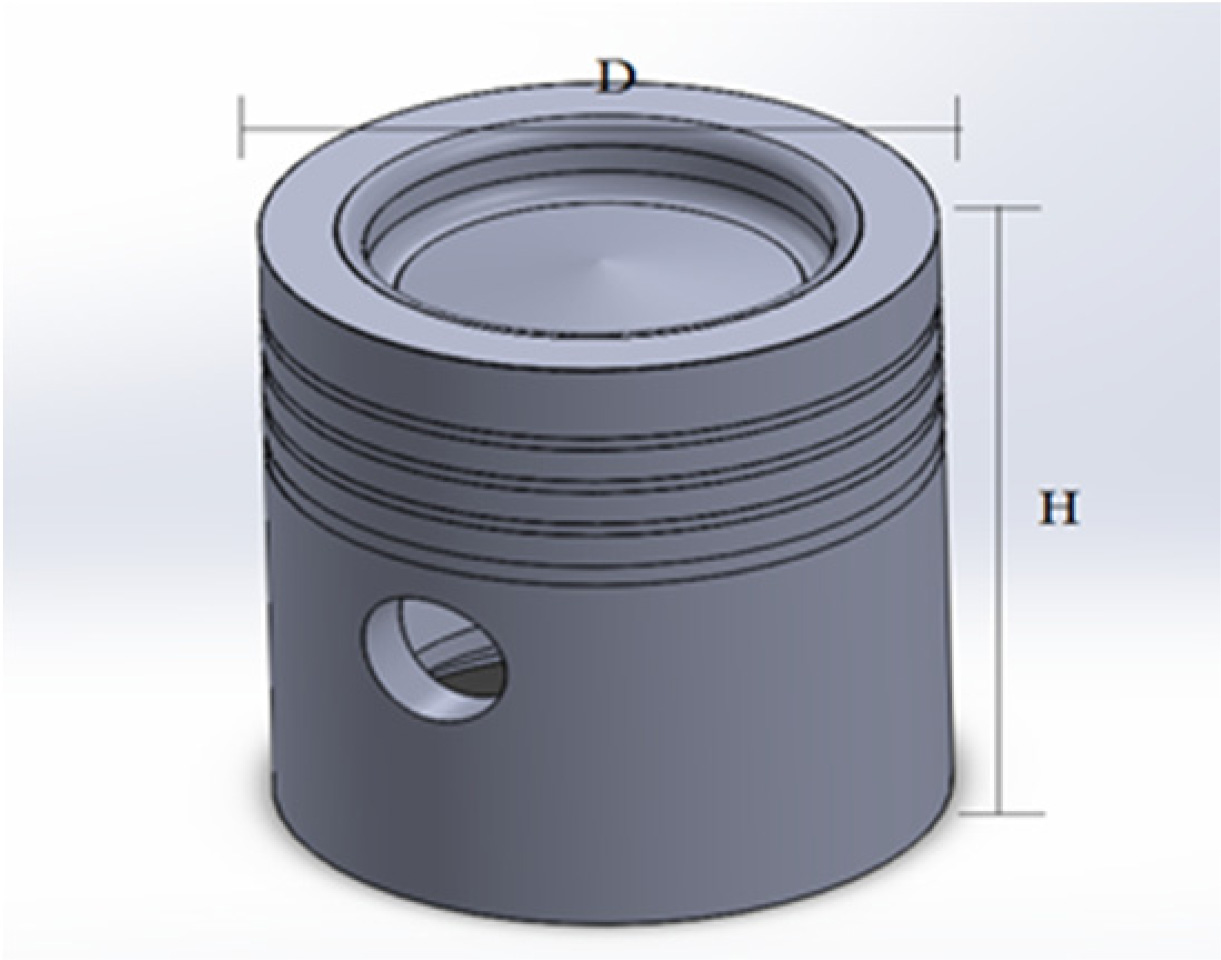
|
Fig. 1 Piston Geometry. |
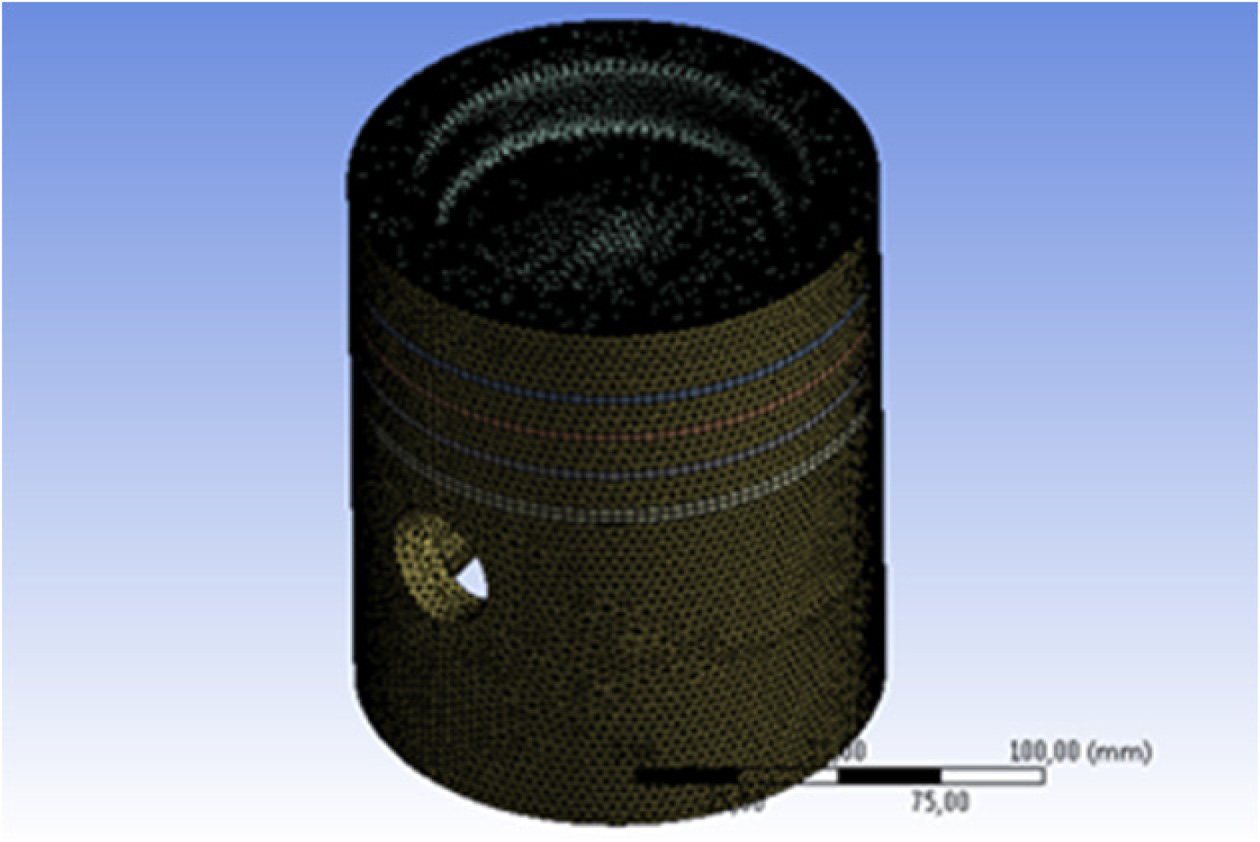
|
Fig. 2 Mesh structure of problem. |
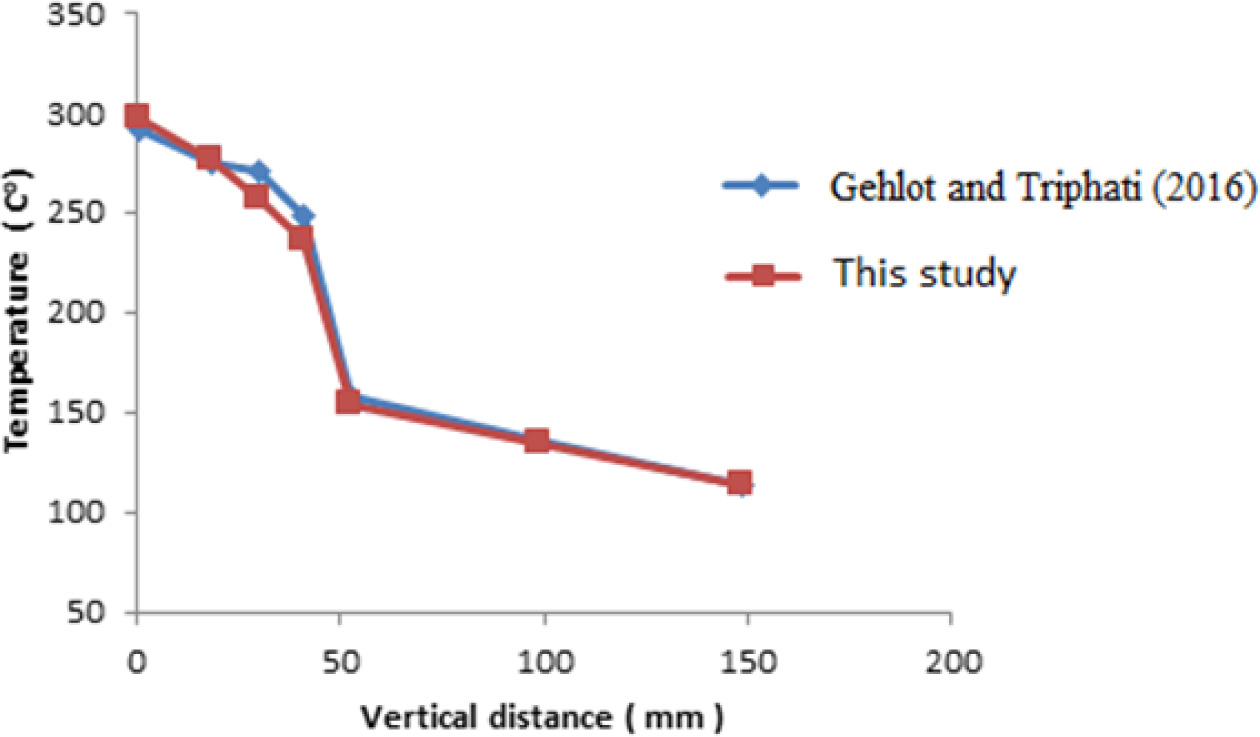
|
Fig. 3 Comparison of piston outer side surface temperature change with literature. |
In this study, functional graded ceramic coating applied
on a designed diesel engine and temperature distribution on piston upper
surface based on bond coating were numerically evaluated for maximum and
minimum temperature changes on piston volume. For this purpose, upper surface
of piston was coated with ceramic to have bond coat thickness of micrometre,
and graded coat thickness of 100, 200, 300, 400, 500 and 600 micrometre. Graded
coating was applied as MgZrO3 and NiCrAl alloy. Piston bond coat was
kept constant as 100 micrometre NiCrAl alloy, and on this layer, graded MgZrO3
was applied with 100%, 90%, 70%, 50%, 30%, and 10% ratio, and
numerical simulations were repeated for graded coating. Some of the
analysis results were presented below.
Fig. 4 showed temperature distributions for graded coat
thickness 300 and different MgZrO3 alloy ratio. In this figure, 6
different states with 100%, 90%, 70%, 50%, 30%, and 10% MgZrO3 were
presented. As seen from figures, temperature distribution on pistons were similar
for all states. While maximum temperature was observed on the upper surface of
the piston, tem- peratures decreased
along the piston, and had minimum value at the bottom surface.
For constant coating thickness, decreased MgZrO3
alloy ratio decreased temperatures observed on all piston surfaces. Especially,
piston upper surface tem- perature
significantly decreased as MgZrO3 alloy ratio decreased. Piston
upper surface maximum temperature value was identified for 100% and 10% MgZrO3
alloy ratio as 379.03 and 302.46 oC respectively. As alloy
ratio of ceramic coating decreased, piston upper surface maximum
temperature approximately decreased 20.2%. For 6
different alloy ratio, piston bottom surface tem- perature was approximately 113 oC.
Therefore, piston bottom surface temperature was not significantly
affected from MgZrO3 alloy ratio.
For different alloy ratios, graphics that show radial
piston upper surface temperature change were plotted for 200, 300, 500 and
600 µm coating thickness. These graphs are presented in Fig. 5. These
figures show radial piston upper surface temperature change along piston
diameter. For constant coating thickness, curves plotted for all alloy ratios
had similar structure. All curves present a symmetrical structure compared to
piston centre. Temperature level slightly changes for first 20 mm distance
from piston outer surface to centre. From this distance, temperature values
suddenly decrease and reach minimum level. Temperature values increase around
piston centre. At the central point of the piston, temperature levels reach
maximum level. This is similar for all analysed alloy ratio and coating thicknesses.
As seen from this figure, for all coating thicknesses,
piston upper surface temperatures are at maximum level when alloy ratio was
100%. With decreases alloy ratio, piston upper surface temperature decreased as
well. When alloy ratio was 90%, piston upper surface temperatures decreased.
When alloy ratio was between 70-10%, temperatures obtained for these ratios had
similar structure. For four coating thickness in the figure, there is similar
structure. Therefore, for constant coating thickness, as ceramic coating MgZrO3
alloy ratio increased, it can be stated that piston upper surface temperature
value increased. Especially when MgZrO3 ratio in coating was 70% or
higher, these ratios have significant effect on piston upper surface
temperature distribution. Additionally, curves for alloy ratio of 70% of lower
were slightly effected from coating thickness increase. Temperatures are at
similar level. However, temperature values for alloy rate of 70% or higher
increases as coating thickness increases. These values
reach maximum value for coating thickness of
600 µm. Therefore, with increasing coating thickness,
temperature difference between 70% and 100% alloy curves increase.
For different coating thickness, graphics that show radial
piston upper surface temperature change were plotted for 100%, 70%, 50% and 30%
ceramic coating alloy ratio. These graphs are presented in Fig. 6. These
figures show radial piston upper surface tem-
perature change along piston diameter. For constant coating thickness,
curves plotted for all alloy ratios had similar structure. All curves present a
symmetrical structure compared to piston centre. As seen from the figure,
for constant alloy rates, increased coating thickness increases
piston upper surface temperature. Especially when coating alloy ratio was 100%
MgZrO3, increased coating thickness can significantly increase
piston upper surface temperature. With decreasing alloy ratio, effect of
coating thickness on temperature distribution decreases as well. Small alloy ratios
has similar temperature curves for all analysed coating thicknesses.
In Fig. 7, piston upper surface temperature changes
for different alloy rates are presented for 200 µm, 300 µm,
500 µm and 600 µm coating thickness. These figures show piston outer surface
temperature change from piston upper surface to piston bottom surface along
vertical axis. When this figure was analysed, for all alloy ratios, upper
surface of the piston showed maximum temperature, and temperatures
decreased along the piston to minimum level. Maximum temperature
on the upper surface of the piston was observed in 100% MgZrO3 alloy
model. With decreased MgZrO3 alloy ratio, piston upper temperature
decreased as well. However, this changed approximately 15mm after the upper
part of the piston and reverse states were observed. While maximum temperature
in that region was observed for 10% MgZrO3 alloy, temperatures
decreased with increased alloy ratio. Especially with increasing
coating thickness, temperature values observed in this region
are effected from coating alloy rate changes. 100 mm after the upper part
of the piston, alloy ratio on the piston had almost no significant effect on
temperature change, and all curves have similar structure in piston skirt. This
is similar for all analysed coating thicknesses.
In Fig. 8, piston central axis temperature changes for
different alloy rates are presented for 200 µm, 300 µm, 500 µm
and 600 µm coating thickness. These figures show piston central axis
temperature change from piston upper surface to piston bottom surface along
vertical axis. When this figure was analysed, for all alloy
ratios, upper surface centre of the piston showed maximum
temperature, and temperatures decreased along piston central axis and reached
minimum level. For piston upper surface centre, maximum temperature was
observed for 100% MgZrO3 alloy coating model and minimum temperature
was observed for 10% MgZrO3 alloy coating model. MgZrO3 alloy
ratio decreased, piston upper central temperature decreased as well. However, this
changed approximately 10-15 mm after the upper part of the piston and reverse
states were observed. From this point, temperature decreases with
increasing alloy rate. While maximum temperature was
observed for 10% MgZrO3, minimum temperature was observed for 100%
MgZrO3. This case was similar along piston central axis. For all
analysed coating thicknesses, temperature curves show similar structure. Additionally,
for 200 µm coating thickness, temperature curves for
different alloy rates have similar levels. However, these curves diverge with
increasing coating thickness.
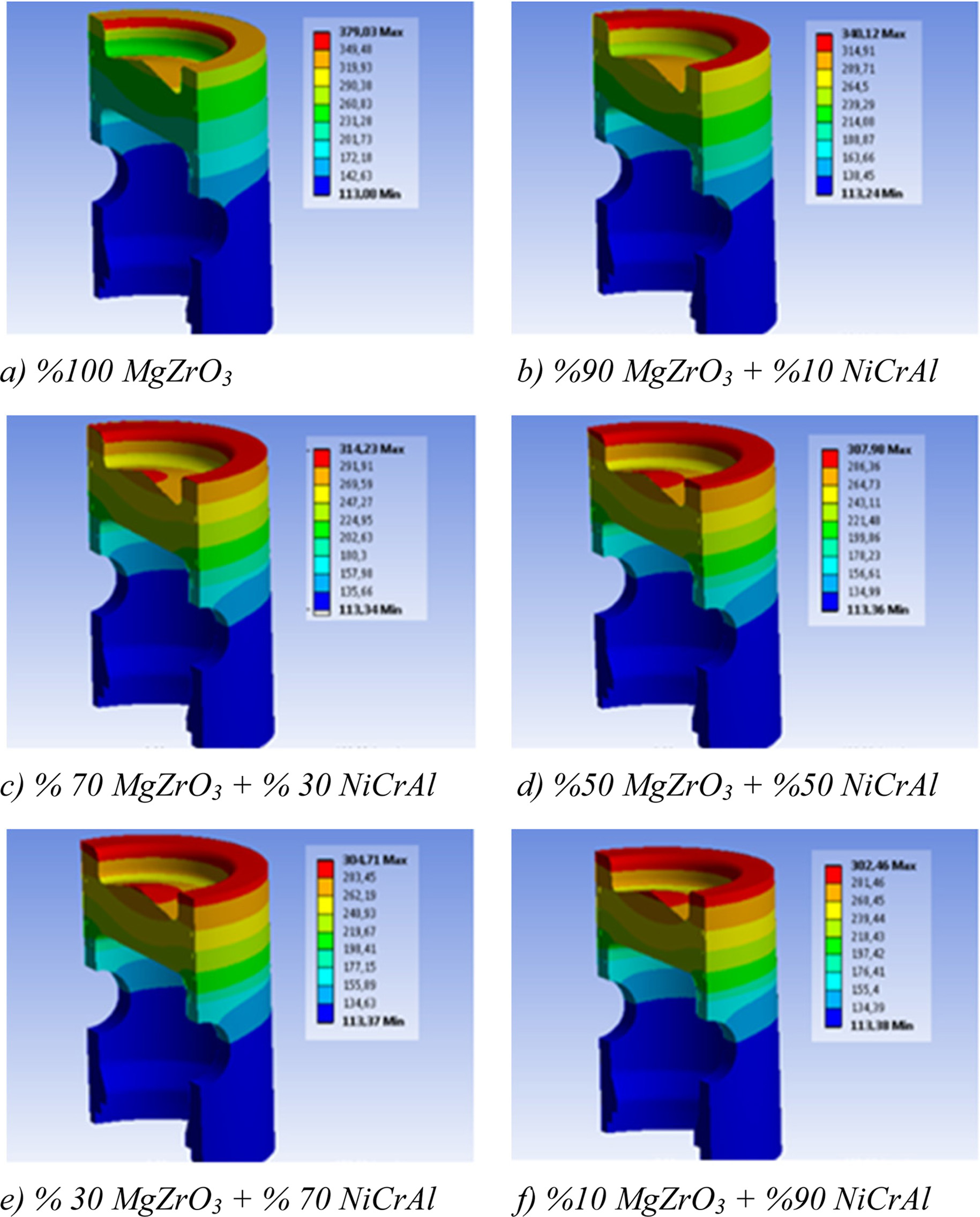
|
Fig. 4 Temperature distributions for a piston with different graded MgZrO3 coating ratios a) 100%, b) 90%, c) 70%, d) 50%, e) 30%, f) 10%. |
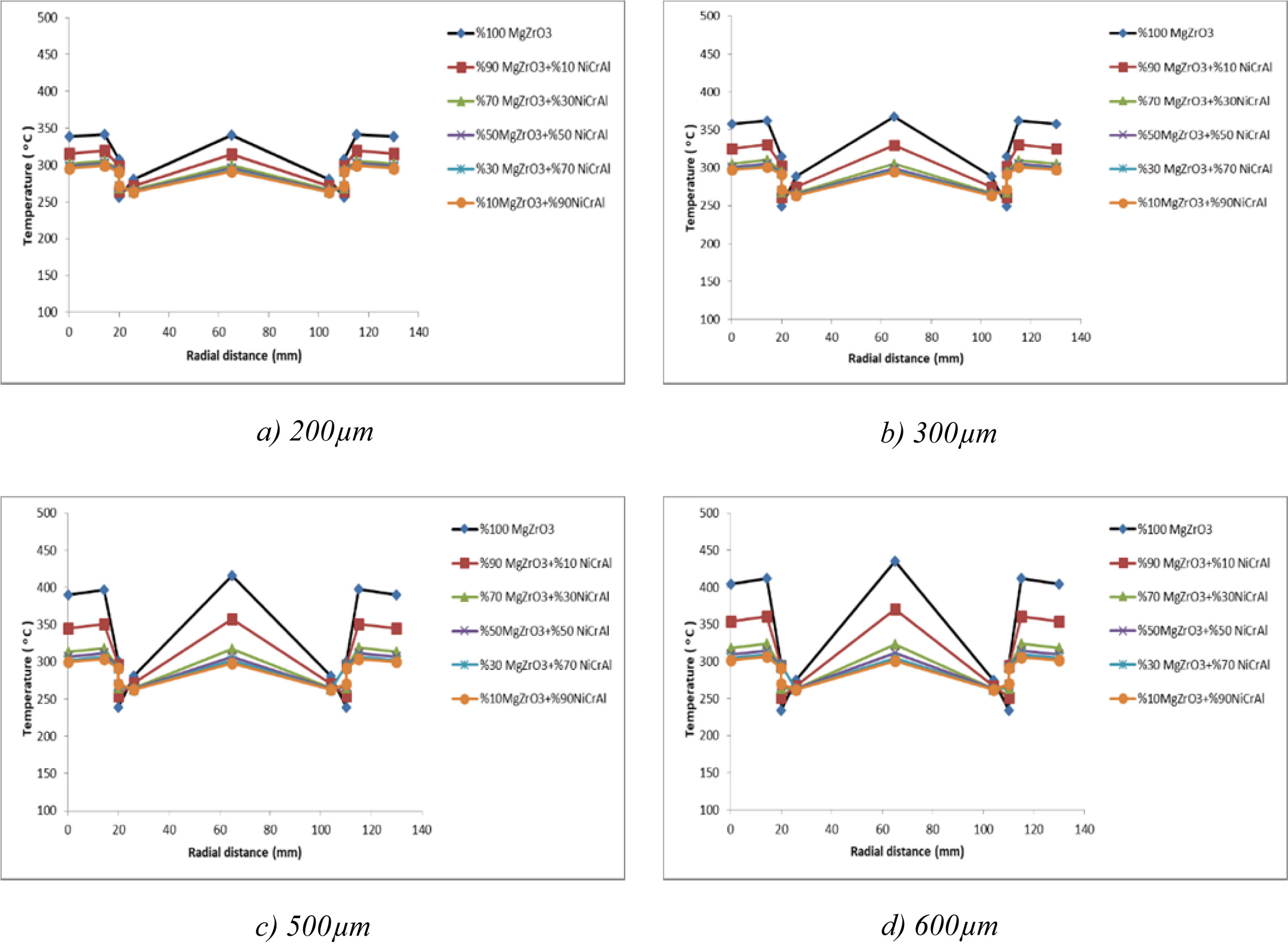
|
Fig. 5 Radial change of piston upper surface temperature for different MgZrO3 ratio a) 200 μm, b) 300 μm, c) 500 μm, d) 600 μm. |
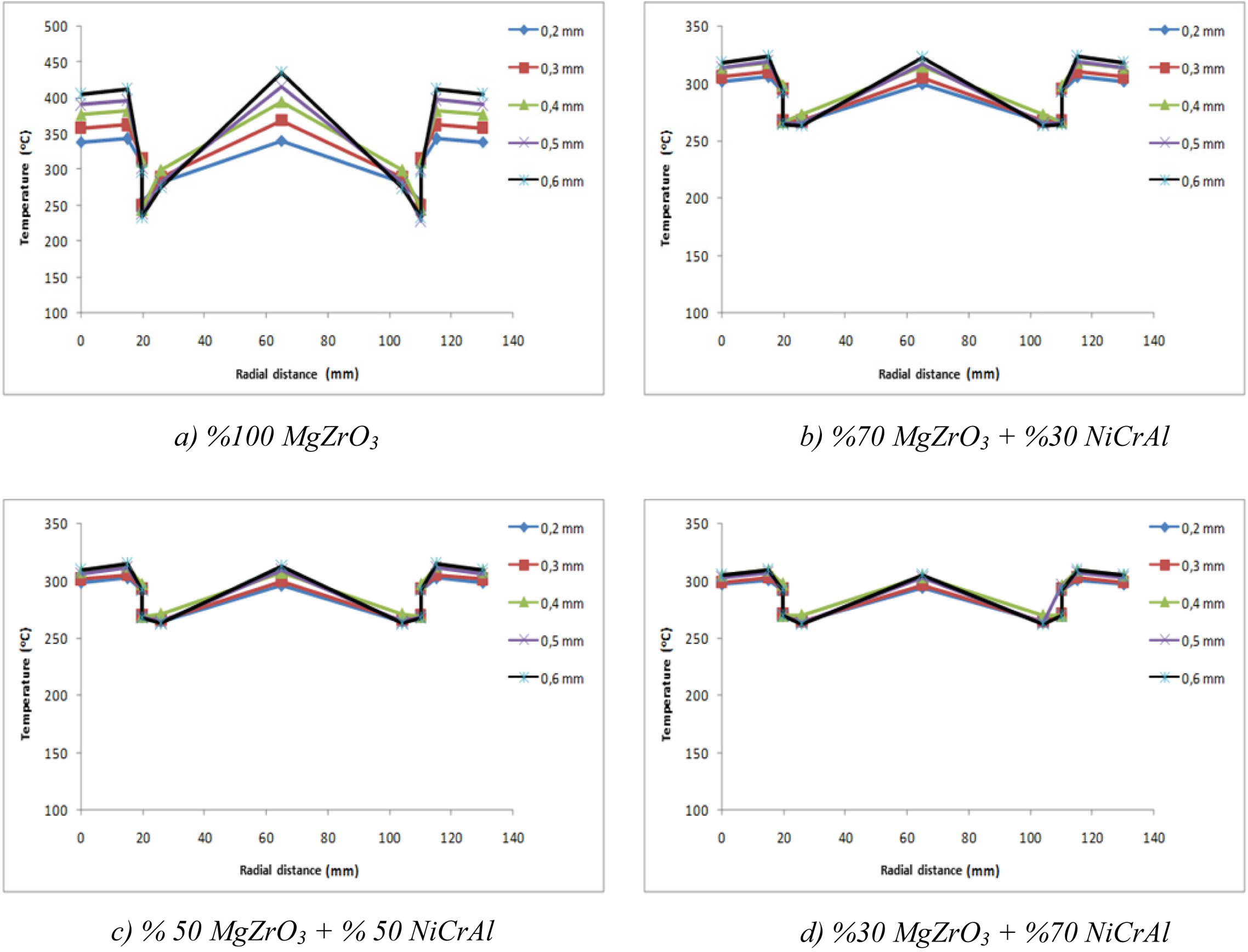
|
Fig. 6 Radial change of piston upper surface temperature for different coating thickness a) %100 MgZrO3, b) %70 MgZrO3, c) %50 MgZrO3, d) %30 MgZrO3. |
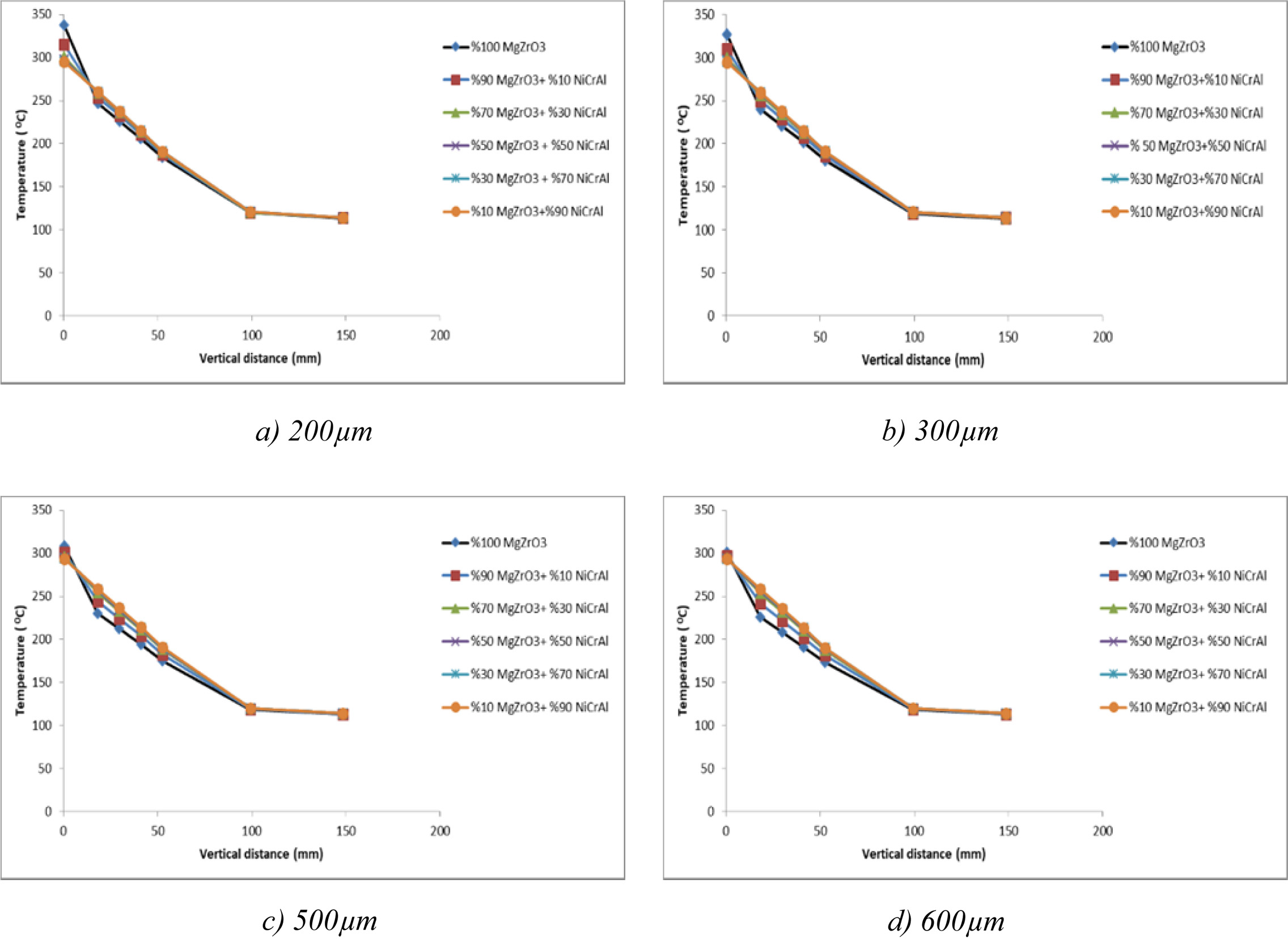
|
Fig. 7 Temperature change along outer edge vertical length of piston for different alloy ratios a) 200 μm, b) 300 μm, c) 500 μm, d) 600 μm. |
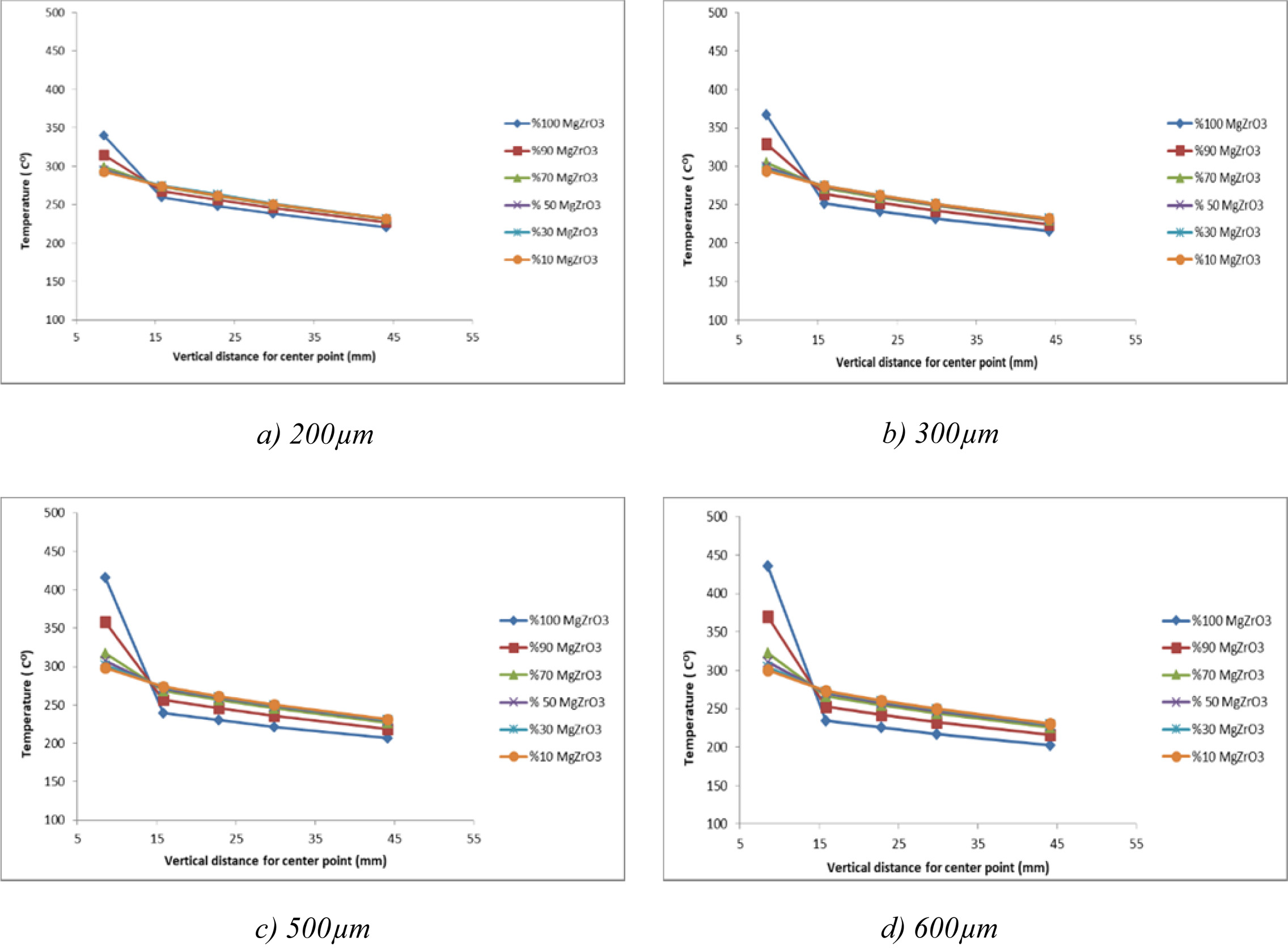
|
Fig. 8 Temperature change of piston central axis along with vertical length for different alloy ratios a) 200 μm, b) 300 μm, c) 500 μm, d) 600 μm. |
In this study, temperature distribution on piston surfaces
were numerically analysed for ceramic thermal barrier coating on diesel engine
piston. 100 micrometre thick NiCrAl coating was applied as bond coat on the
upper surface of the piston. On this coating, graded MgZrO3+NiCrAl
alloy with 100, 200, 300, 400, 500 and 600 micrometre thicknesses were applied
for different alloy ratios. In graded coated sections of piston, simulations
were repeated for 100%, 90%, 70%, 50%, 30%, and 10% MgZrO3.
As a result of the analysis, it was determined that for all alloy
ratios, upper surface of the piston showed maximum temperature, and
temperatures decreased along the piston to minimum level at piston skirt
region. Maximum temperature on the upper surface of the piston was observed in
100% MgZrO3 alloy model. MgZrO3 alloy ratio decreased,
piston upper temperature decreased as well. In skirt region of the piston, it
was observed that alloy ratio had no significant effect on
temperature values. Minimum upper surface temperatures were
determined for alloy ratio between 70-10% and it was observed that these temperatures
were similar. All these coating thicknesses showed
similar behaviour. For constant alloy ratio, increased coating thickness also
increased piston upper surface temperature. As a result,
using different functional graded materials on a piston
increases piston resistance, enables upper surface of piston to achieve higher
temperatures, thus, increases overall thermal efficiency. Considering this
factors, it could be stated that 600 µm thickness and 100% MgZrO3
alloy coated piston model was the best state for analysed problem.
Preliminary work of this paper are presented as abstract
proceeding in Engineers of the Future International Student Symposium-EFIS2017
organised in Zonguldak, Turkey between 07-09 June 2018.
- 1. M. Cerit and M. Çoban, Int. J. Therm. Sci. 77 (2014) 11-18.
-

- 2. E. Büyükkaya, Surf. Coat. Tech. 202[16] (2008) 3856-3865.
-

- 3. E. Büyükkaya and M. Cerit, Surf. Coat. Tech. 202 (2007) 398-402.
-

- 4. R. Gehlot and B. Tripathi, J. Case Stu. Therm. Eng. 8 (2016) 291-299.
-

- 5. M. Cerit, V. Ayhan, A. Parlak, and H. Yasar, J. App. Therm. Eng. 31[2-3] (2011) 336-341.
-

- 6. D. Robinson and R. Palaninathan, Int. J. Fin. Elem. Analy. Des. 37[2] (2001) 85-95.
-

- 7. O.R. Kummitha and B.V.R. Reddy, J. Mater. T. 4[8] (2017) 8142-8148.
-

- 8. N.Y. Dudareva, R.D. Enikeev, and V.Y. Ivanov, Proc. Eng. 206 (2017) 1382-1387.
-

- 9. B. Dhinesh, Y.M.A. Raj, C. Kalaiselvan, and R. Krishna- Moorthy, Energy Conv. Man. 171 (2018) 815-824.
-

- 10. M. Yao, T. Ma, H. Wang, Z. Zheng, H. Liu, and Y. Zhang, Energy. 162 (2018) 744-752.
-

- 11. G.X. Lu, L.J. Hao, C. Liu, and F.X. Ye, Mater. Sci. Tech. 30[11] (2014) 1273-1282.
-

- 12. J. Muthusamy, G. Venkadesan, and U. Krishnavel, Therm. Sci. 20[4] (2016) S1189-S1196.
-

- 13. M. Cerit, Surf. Coat. Tech. 205[11] (2011) 3499-3505.
-

- 14. T.S. Sachit, R.V. Nandish, and Mallikarjun, Mater. T. Proc. 5[2] (2018) 5074-5081.
-

- 15. Z. Yao and Z. Qian, J. Alloy Comp. 768 (2018) 441-450.
-

- 16. S. Mahade, N. Curry, K.P. Jonnalagadda, R.L. Peng, N. Markocsan, and P. Nylén, Surf. Coat. Tech. 357 (2019) 456-465.
-

- 17. V. Garud, S. Bhoite, S. Patil, S. Ghadage, N. Gaikwad, D. Kute, and G. Sivakumar, Mater. T. Proc. 4[2] (2017) 188-194.
-

- 18. Z. Yao, K. Hu, and R. Li, J. Alloy Comp. 790 (2019) 466-479.
-

- 19. G. Venkadesan and J. Muthusamy, Cer. Int. 45[3] (2019) 3166-3176.
-

- 20. J. Moon, H. Choi, and C. Lee, J. Ceram. Process. Res. 1[1] (2000) 69-73.
- 21. D.H. Lee, B. Jang, C. Kim, and K.S. Lee, J. Ceram. Process. Res. 20[5] (2019) 499-504.
- 22. J.H. Cho, T.W. Kim, Y.G. Jung, K.D. Lee, J. Ceram. Process. Res. 10[3] (2009) 344-350.
- 23. J.W. Lee, C.H. Lee, H.J. Kim, J. Ceram. Process. Res. 2[3] (2001) 113-119.
- 24. S.H. Kim, Z.Y. Fu, K. N, and S.W. Lee, J. Ceram. Process. Res. 12[2] (2011) 126-131.
- 25. Z. Yao and W. Li, J. Alloy Comp. 812 (2020) 152162.
-

- 26. S. Caputo, F. Millo, G. Boccardo, A. Piano, G. Cifali, and F.C. Pesce, J. App. Therm. Eng. 162 (2019) 114233.
-

- 27. V.R. Reghu, A. Basha, K. Lobo, S. Shivakumar, P. Tilleti, V. Shankar, and P. Ramaswamy, Mater. T. Proc. 19 (2019) 630-636.
-

- 28. P. Ramaswamy, V. Shankar, V.R. Reghu, N. Mathew, and S. Manoj Kumar, Mater. T. Proc. 5 (2018) 12623-12631.
-

- 29. H. Yerrennagoudaru and K. Manjunatha, Mater. T. Proc. 4[2] (2017) 2333-2340.
-

 This Article
This Article
-
2020; 21(4): 433-441
Published on Aug 30, 2020
- 10.36410/jcpr.2020.21.4.433
- Received on Jan 21, 2020
- Revised on Apr 4, 2020
- Accepted on Apr 7, 2020
 Services
Services
- Abstract
introduction
definition of problem and mathematical formulation
findings and discussion
results
- Note
- References
- Full Text PDF
Shared
 Correspondence to
Correspondence to
- Tolga Demircan
-
Department of Mechanical Engineering, Faculty of Engineering, Kırıkkale University, Kırıkkale, Turkey
Tel : +90 3183574242 / 1057
Fax: +90 3183572459 - E-mail: tolgademircan@gmail.com






 Copyright 2019 International Orgranization for Ceramic Processing. All rights reserved.
Copyright 2019 International Orgranization for Ceramic Processing. All rights reserved.